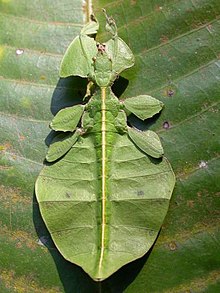Mimesis

As Mimese (from ancient Greek μίμησις MIMESIS , German , imitation ' ) is in the Biology a form of camouflage referred to, wherein a subject in shape, color and attitude assumes a part of its habitat and no distinction as to optically aligned enemies of the environment can be. The mimicry is also known as camouflage or concealment and differs from the mimicry , which is a warning costume . In English usage, however, mimetics is often counted as mimicry.
According to the type of imitated objects, mimesis is divided:
- When zooming , the appearance is similar to other animals. In contrast to mimicry, the role model does not have to be defensive or toxic. Examples are some ant guests ( myrmecophilia ), who resemble the ants in whose nests they live.
- In phytomimesis , plants or parts of plants are imitated. Some caterpillars look like thin branches. Terrors have a body shape that also resembles that of twigs ( stick insects ) or leaves ( walking leaf ). The moths of the toothed spinner can hardly be distinguished from the bark of deciduous trees, which is also known as bark mimesis . Some species in this family, such as the birch fork tail or the beech fork tail, have cocoons of their pupae that also look like bark.
- When Allomimese inanimate objects serve as role models. Some small butterflies look like bird droppings. Several representatives of the Aizoaceae plant family , which are native to African deserts, resemble stones and are referred to as "living stones" .
This type of camouflage was already used 50 million years ago by small butterflies , which in the larval stage camouflaged their quiver with all kinds of objects from the forest floor. Examples are as inclusions ( inclusions preserved) in Baltic amber.
Leaf- tailed gecko (Uroplatus)
Moon bird
(Phalera bucephala)Caterpillar of the knightly butterfly Papilio cresphontes
(bird droppings)Dead leaf
(Drepanepteryx phalaenoides)"Living stones"
(Lithops)
Individual evidence
- ^ Wilhelm Pape , Max Sengebusch (arrangement): Concise dictionary of the Greek language . 3rd edition, 6th impression. Vieweg & Sohn, Braunschweig 1914 ( zeno.org ).
- ↑ Adolf Remane, Volker Storch, Ulrich Welsch: Kurzes Lehrbuch der Zoologie . 6th edition, Gustav Fischer Verlag, Stuttgart 1989, ISBN 3-437-20436-X , p. 352.
- ↑ a b c d e Matthias Schaefer: Dictionary of Ecology . 4th edition, Spektrum Akademischer Verlag, Heidelberg, Berlin 2003, ISBN 3-8274-0167-4 .
- ↑ Wolfgang Weitschat: Hunters, the hunted, parasites and stowaways - snapshots from the amber forest. In: Denisia 26, Neue Serie 86, pp. 243-256, 50 figs., Linz 2009.





